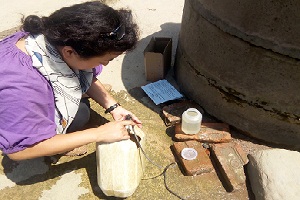
Water Sampling at Liwali
After the massive earthquake, 2015 the local residents at Liwali 2, Bhaktpur are facing water scarcity challenges. The people displaced during the earthquake are temporarily residing at Liwali. The major source of water supply for the people living in Liwali is a dug well. The water from the dug well is being used for cleaning, dish washing, and cloth washing by the residents at Liwali. Water quality test is necessary to ensure that water from the well is safe and free from harmful chemicals and pathogens.
Under the Emergency Rain Project, GUTHI collected water samples from the dug well and submitted for the water quality test to Environment and Public Health Organization (ENPHO) laboratory at Thapagaun.
During the water quality test, the basic physical, chemical and microbiological parameters were used for the analysis. The physical parameters constitute of pH and turbidity; the chemical parameters constitute of total harness, chloride, manganese, nitrate, ammonia, iron and arsenic; and microbiological parameter constitutes of total coliform and E. Coli test for pathogens presence.
From the water quality lab test, the amount of physical parameters likes turbidity, Ammonia, Iron, and Manganese exceeded the standard water sample from National Drinking Water Quality Standard (2062). Similarly, the biological parameters like total Coliform and E. Coli was observed to be contaminated during the water quality test. Other parameters like pH, Total Hardness of CaCO3, Chloride, Nitrate and Arsenic were found to be within the range of standard water sample. Therefore, these results indicated that the quality of water needs further treatment to be safe and clean for drinking purpose. It is important to ensure safe water consumption as such contaminated water consumption can lead to chronic and communicable health hazards.
The below table gives the overview of parameter that exceeds the standard water sample test:
|
SN |
Test name |
Lab result |
Standard value |
Treatment |
Remarks/ Health Hazards |
|
1. |
Turbidity |
35 |
5 (10) |
Proper filtration and continuous disinfectants can reduce the effects of high turbidity |
Water is from the poor well |
|
2. |
Ammonia |
2.1 |
1.5 |
Reverse Osmosis and ion exchange ( strong base anion exchange) |
Water is contaminated with sewage, animal wastes, or fertilizers runoff. |
|
3. |
Iron |
3.5 |
0.3 (3) |
The most common practices are chlorination and aeration [injecting air] into the well followed by filtration and boiling |
Stain in laundry and water vessels |
|
4. |
Manganese |
1.4 |
0.2 |
Use of a cation-exchange water softener system |
Excessive exposure to the manganese contaminated water is responsible for Central Nervous System (CNS) problems like Parkinson’s diseases |
|
5. |
E. Coli |
240 |
0 |
Continuous disinfection be use in order to remove the cause of contamination or by repairing an replacing sources of contamination |
Can cause food-borne and water-borne illness leading to bloody diarrhea and abdominal cramps |
By Junita Mulmi, GUTHI